Solar eclipse of November 22, 1919
| Solar eclipse of November 22, 1919 | |
|---|---|
 Map | |
| Type of eclipse | |
| Nature | Annular |
| Gamma | 0.4549 |
| Magnitude | 0.9198 |
| Maximum eclipse | |
| Duration | 697 sec (11 m 37 s) |
| Coordinates | 6°54′N 48°54′W / 6.9°N 48.9°W |
| Max. width of band | 341 km (212 mi) |
| Times (UTC) | |
| Greatest eclipse | 15:14:12 |
| References | |
| Saros | 141 (18 of 70) |
| Catalog # (SE5000) | 9327 |
An annular solar eclipse occurred on November 22, 1919. A solar eclipse occurs when the Moon passes between Earth and the Sun, thereby totally or partly obscuring the image of the Sun for a viewer on Earth. An annular solar eclipse occurs when the Moon's apparent diameter is smaller than the Sun's, blocking most of the Sun's light and causing the Sun to look like an annulus (ring). An annular eclipse appears as a partial eclipse over a region of the Earth thousands of kilometres wide. It occurred in over half of North America, much of South America, a part of Western Europe and about a third of Africa.
Places inside the annular eclipse included North America and the Caribbean, including Austin, San Antonio, Houston and Galveston, Texas in the United States and was close to Mexico at around 7:30 CT (13:30 UTC), more than a quarter of the Gulf of Mexico and close to the Florida Keys in the United States which occurred before 8:45 ET (13:45 UTC), it also included Cuba, most of Haiti and the southwesternmost Dominican Republic , it was almost near Venezuela and it included Saint Vincent and the Grenadines and Barbados which happened in the mid morning hours. The greatest eclipse occurred at 15:14:12 UTC. In Africa, it included the Gambia, southern Senegal including Casamance, Portuguese Guinea (now Guinea-Bissau), the northern part of French Guinea (now Guinea) which occurred before 15:45 (16:45 UTC) and southeasternmost Mauritania and the middle portion of the French Sudan (now Mali) which included Bamako and Timbuktu, it occurred in the late afternoon before sunset at 17:00 UTC.
Related eclipses
Solar eclipses 1916-1920
Each member in a semester series of solar eclipses repeats approximately every 177 days and 4 hours (a semester) at alternating nodes of the Moon's orbit.
| Solar eclipse series sets from 1916–1920 | ||||
|---|---|---|---|---|
| Ascending node | Descending node | |||
| 111 | December 24, 1916 Partial |
116 | June 19, 1917 Partial | |
| 121 | December 14, 1917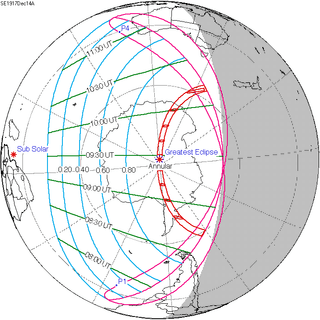 Annular |
126 | June 8, 1918 Total | |
| 131 | December 3, 1918 Annular |
136 | May 29, 1919 Total | |
| 141 | November 22, 1919 Annular |
146 | May 18, 1920 Partial | |
| 151 | November 10, 1920 Partial | |||
Saros 141
Solar Saros 141 repeats every 18 years, 11 days and contains 70 events. The series started with partial solar eclipse on May 19, 1613. It contains annular eclipses from August 4, 1739 through October 14, 2460. There are no total eclipses in this series. The series ends at member 70 as a partial eclipse on June 13, 2857. [1]
| Series members 17–28 occur between 1901 and 2100 | ||
|---|---|---|
| 17 | 18 | 19 |
 November 11, 1901 |
 November 22, 1919 |
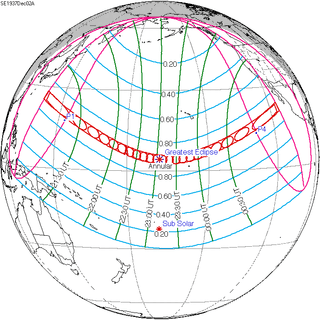 December 2, 1937 |
| 20 | 21 | 22 |
 December 14, 1955 |
 December 24, 1973 |
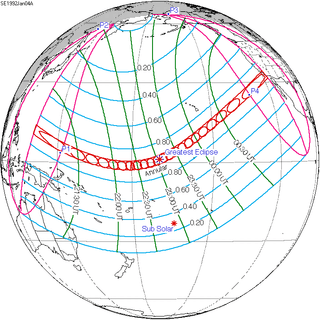 January 4, 1992 |
| 23 | 24 | 25 |
 January 15, 2010 |
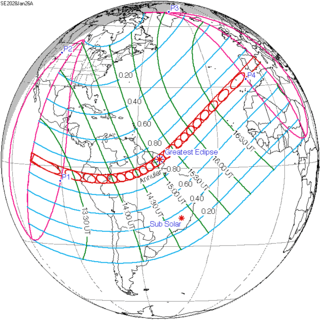 January 26, 2028 |
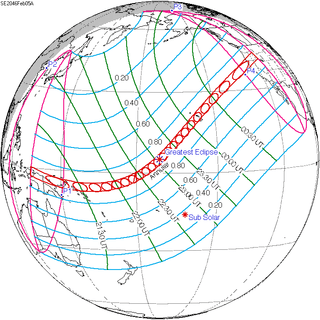 February 5, 2046 |
| 26 | 27 | 28 |
 February 17, 2064 |
 February 27, 2082 |
 March 10, 2100 |
Notes
- ↑ "NASA - Catalog of Solar Eclipses of Saros 141". Eclipse.gsfc.nasa.gov. Retrieved 2012-03-15.
References
- Earth visibility chart and eclipse statistics Eclipse Predictions by Fred Espenak, NASA/GSFC
| Wikimedia Commons has media related to Solar eclipse of 1919 November 22. |
